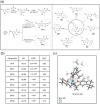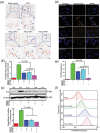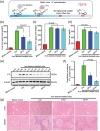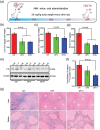New Deferric Amine Compounds Efficiently Chelate Excess Iron to Treat Iron Overload Disorders and to Prevent Ferroptosis
- PMID: 36031399
- PMCID: PMC9561787
- DOI: 10.1002/advs.202202679
New Deferric Amine Compounds Efficiently Chelate Excess Iron to Treat Iron Overload Disorders and to Prevent Ferroptosis
Abstract
Excess iron accumulation occurs in organs of patients with certain genetic disorders or after repeated transfusions. No physiological mechanism is available to excrete excess iron and iron overload to promote lipid peroxidation to induce ferroptosis, thus iron chelation becomes critical for preventing ion toxicity in these patients. To date, several iron chelators have been approved for iron chelation therapy, such as deferiprone and deferoxamine, but the current iron chelators suffer from significant limitations. In this context, new agents are continuously sought. Here, a library of new deferric amine compounds (DFAs) with adjustable skeleton and flexibility is synthesized by adopting the beneficial properties of conventional chelators. After careful evaluations, compound DFA1 is found to have greater efficacy in binding iron through two molecular oxygens in the phenolic hydroxyl group and the nitrogen atom in the amine with a 2:1 stoichiometry. This compound remarkably ameliorates iron overload in diverse murine models through both oral and intravenous administration, including hemochromatosis, high iron diet-induced, and iron dextran-stimulated iron accumulation. Strikingly, this compound is found to suppress iron-induced ferroptosis by modulating the intracellular signaling that drives lipid peroxidation. This study opens a new approach for the development of iron chelators to treat iron overload.
Keywords: deferric amine compound; ferroptosis; iron chelator; iron overload; liver injury.
© 2022 The Authors. Advanced Science published by Wiley-VCH GmbH.
Conflict of interest statement
The authors declare no conflict of interest.
Figures







Similar articles
-
Advances in iron overload therapies. prospects for effective use of deferiprone (L1), deferoxamine, the new experimental chelators ICL670, GT56-252, L1NA11 and their combinations.Curr Med Chem. 2005;12(23):2663-81. doi: 10.2174/092986705774463003. Curr Med Chem. 2005. PMID: 16305464 Review.
-
Comparative study of the protective effect between deferoxamine and deferiprone on chronic iron overload induced cardiotoxicity in rats.Hum Exp Toxicol. 2006 Jul;25(7):375-85. doi: 10.1191/0960327106ht637oa. Hum Exp Toxicol. 2006. PMID: 16898166
-
Effective new treatments of iron overload in thalassaemia using the ICOC combination therapy protocol of deferiprone (L1) and deferoxamine and of new chelating drugs.Haematologica. 2006 Jun;91(6 Suppl):ELT04. Haematologica. 2006. PMID: 16785141
-
Transfusional iron overload and chelation therapy with deferoxamine and deferiprone (L1).Transfus Sci. 2000 Dec;23(3):211-23. doi: 10.1016/s0955-3886(00)00089-8. Transfus Sci. 2000. PMID: 11099897 Review.
-
Chelation therapy for iron overload.Curr Gastroenterol Rep. 2007 Mar;9(1):74-82. doi: 10.1007/s11894-008-0024-9. Curr Gastroenterol Rep. 2007. PMID: 17335681 Review.
Cited by
-
Iron and Targeted Iron Therapy in Alzheimer's Disease.Int J Mol Sci. 2023 Nov 15;24(22):16353. doi: 10.3390/ijms242216353. Int J Mol Sci. 2023. PMID: 38003544 Free PMC article. Review.
-
In situ implantable DNA hydrogel for diagnosis and therapy of postoperative rehemorrhage following intracerebral hemorrhage surgery.Sci Adv. 2024 Aug 16;10(33):eado3919. doi: 10.1126/sciadv.ado3919. Epub 2024 Aug 14. Sci Adv. 2024. PMID: 39141742 Free PMC article.
-
Effects of Ferroptosis on Cardiovascular Diseases.Mediators Inflamm. 2023 May 4;2023:6653202. doi: 10.1155/2023/6653202. eCollection 2023. Mediators Inflamm. 2023. PMID: 37181809 Free PMC article. Review.
-
New insights into crosstalk between Nrf2 pathway and ferroptosis in lung disease.Cell Death Dis. 2024 Nov 18;15(11):841. doi: 10.1038/s41419-024-07224-1. Cell Death Dis. 2024. PMID: 39557840 Free PMC article. Review.
-
Targeting the initiator to activate both ferroptosis and cuproptosis for breast cancer treatment: progress and possibility for clinical application.Front Pharmacol. 2025 Jan 10;15:1493188. doi: 10.3389/fphar.2024.1493188. eCollection 2024. Front Pharmacol. 2025. PMID: 39867656 Free PMC article. Review.
References
-
- a) Adams P. C., Reboussin D. M., Barton J. C., McLaren C. E., Eckfeldt J. H., McLaren G. D., Dawkins F. W., Acton R. T., Harris E. L., Gordeuk V. R., Leiendecker‐Foster C., Speechley M., Snively B. M., Holup J. L., Thomson E., Sholinsky P., Acton R. T., Barton J. C., Dixon D., Rivers C. A., Tucker D., Ware J. C., McLaren C. E., McLaren G. D., Anton‐Culver H., Baca J. A., Bent T. C., Brunner L. C., Dao M. M., Jorgensen K. S., et al., N. Engl. J. Med. 2005, 352, 1769; - PubMed
- b) Allen K. J., Gurrin L. C., Constantine C. C., Osborne N. J., Delatycki M. B., Nicoll A. J., McLaren C. E., Bahlo M., Nisselle A. E., Vulpe C. D., Anderson G. J., Southey M. C., Giles G. G., English D. R., Hopper J. L., Olynyk J. K., Powell L. W., Gertig D. M., N. Engl. J. Med. 2008, 358, 221; - PubMed
- c) Pietrangelo A., N. Engl. J. Med. 2004, 350, 2383. - PubMed
Publication types
MeSH terms
Substances
Grants and funding
- 21920102007/National Natural Science Foundation of China
- 22150006/National Natural Science Foundation of China
- 22076210/National Natural Science Foundation of China
- 2021YFE0101500/Ministry of Science and Technology of the People's Republic of China
- 121311KYSB20190010/International Collaboration Key Grant from the Chinese Academy of Sciences
